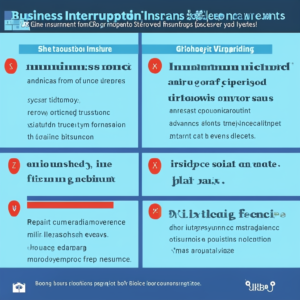Introduction
For businesses, commercial property insurance serves as a critical safety net, protecting physical assets from a variety of risks. However, many business owners may not realize that their policies often contain hidden exclusions that can lead to devastating financial consequences. These exclusions can leave businesses vulnerable to significant losses in the event of unforeseen incidents, such as natural disasters or equipment failures. In this blog post, we will delve into the world of commercial property insurance, shedding light on common hidden exclusions that could cost you millions and emphasizing the importance of understanding your coverage.
Understanding Commercial Property Insurance
Definition and Purpose of Commercial Property Insurance
Commercial property insurance is a type of insurance designed to protect businesses from financial losses due to damage or loss of physical assets. This insurance covers a wide range of property types, including buildings, equipment, inventory, and other tangible assets that are essential for the operation of a business. The primary purpose of commercial property insurance is to provide financial protection against risks such as fire, theft, vandalism, natural disasters, and other unforeseen events that could lead to significant financial setbacks.
For businesses, the implications of property damage can be severe. Without adequate insurance coverage, a business may struggle to recover from losses, leading to operational disruptions, decreased revenue, and even bankruptcy in extreme cases. Commercial property insurance not only helps businesses recover from such incidents but also provides peace of mind, allowing business owners to focus on their operations without the constant worry of potential financial ruin due to property-related risks.
In addition to protecting physical assets, commercial property insurance can also play a crucial role in enhancing a business’s credibility. Clients and partners often prefer to work with insured businesses, as it demonstrates a commitment to risk management and financial responsibility. Overall, commercial property insurance is an essential component of a comprehensive risk management strategy for any business, regardless of its size or industry.
Key Components of a Commercial Property Insurance Policy
A commercial property insurance policy typically consists of several key components that define the scope of coverage and the specific protections offered to the insured business. Understanding these components is crucial for business owners to ensure they have adequate coverage tailored to their needs.
Coverage for Buildings and Structures
One of the primary components of a commercial property insurance policy is coverage for buildings and structures. This coverage protects the physical premises where a business operates, including the main building, warehouses, and any other structures on the property. In the event of damage due to covered perils such as fire, storms, or vandalism, the insurance policy will provide funds for repairs or rebuilding.
The coverage amount is typically based on the replacement cost of the building, which is the cost to rebuild the structure using similar materials and construction methods. Business owners should regularly assess the value of their property to ensure that their coverage limits are adequate, especially if they have made significant improvements or expansions to their facilities.
Coverage for Business Personal Property
In addition to protecting buildings, commercial property insurance also includes coverage for business personal property. This component covers the tangible assets owned by the business, such as furniture, equipment, inventory, and machinery. If these items are damaged or lost due to covered events, the policy will provide compensation for their repair or replacement.
Business personal property coverage is essential for maintaining operational continuity. For example, if a business’s equipment is damaged in a fire, the insurance can help cover the costs of purchasing new equipment, allowing the business to resume operations as quickly as possible. Business owners should keep an updated inventory of their personal property and regularly review their coverage limits to ensure they are adequately protected.
Additional Coverages (e.g., Loss of Income, Equipment Breakdown)
Many commercial property insurance policies also offer additional coverages that can provide further protection for businesses. One important additional coverage is loss of income insurance, which compensates businesses for lost revenue during periods of interruption caused by covered events. For instance, if a fire damages a business’s premises, loss of income insurance can help cover operating expenses and lost profits while the business is temporarily closed for repairs.
Another valuable additional coverage is equipment breakdown insurance, which protects against the costs associated with the failure of essential equipment. This coverage can be particularly important for businesses that rely heavily on machinery or technology to operate. If equipment breaks down unexpectedly, this insurance can help cover repair costs and minimize downtime.
Other optional coverages may include protection against natural disasters, such as floods or earthquakes, which may not be included in standard policies. Business owners should carefully assess their specific risks and consider adding these additional coverages to their policies to ensure comprehensive protection.
Understanding commercial property insurance is essential for business owners to safeguard their physical assets and ensure operational continuity. By recognizing the definition and purpose of this insurance, as well as the key components of a commercial property insurance policy, businesses can make informed decisions about their coverage needs and protect themselves against potential financial losses.
The Importance of Knowing Your Policy
The Complexity of Insurance Policies
Insurance policies can often be intricate and challenging to navigate, making it essential for policyholders to fully understand the terms and conditions outlined within them. The complexity arises from various factors, including the legal jargon used, the numerous exclusions and limitations, and the specific coverage options available. Each policy is tailored to address different risks and needs, which can lead to confusion if not carefully examined.
For business owners, this complexity can have significant implications. A lack of understanding of the policy can result in inadequate coverage, leaving businesses vulnerable to financial losses in the event of a claim. For instance, if a business owner assumes that their policy covers all types of property damage without reviewing the exclusions, they may find themselves unprotected when a specific incident occurs. Therefore, it is crucial for policyholders to take the time to familiarize themselves with their insurance policies, ensuring they comprehend the coverage provided and any limitations that may apply.
The insurance landscape is continually evolving, with new products and coverage options emerging regularly. This dynamic nature adds another layer of complexity, as businesses must stay informed about changes in the market and how they may affect their existing policies. Engaging with insurance professionals and seeking guidance can help demystify the complexities of insurance policies, enabling policyholders to make informed decisions about their coverage.
The Role of Policy Language in Determining Coverage
The language used in insurance policies plays a critical role in determining the extent of coverage provided. Insurance policies are legal documents that outline the rights and responsibilities of both the insurer and the insured. The specific wording can significantly impact how claims are interpreted and processed, making it essential for policyholders to pay close attention to the language used.
Key terms and phrases within a policy can dictate what is covered and what is excluded. For example, terms like “all risks,” “named perils,” or “occurrence” can have specific legal meanings that affect the scope of coverage. Additionally, the presence of exclusions, endorsements, and conditions can further define the parameters of the policy. Misunderstanding or overlooking these terms can lead to disputes during the claims process, potentially resulting in denied claims or reduced payouts.
The clarity of policy language can vary significantly between different insurance providers. Some insurers may use straightforward language, while others may employ more complex terminology. This inconsistency can create confusion for policyholders, emphasizing the importance of thoroughly reviewing and understanding the specific language used in their policies. Engaging with an insurance agent or broker can provide valuable insights into the nuances of policy language, helping policyholders grasp the implications of the terms and conditions.
The Necessity of Thorough Policy Review and Understanding
Thoroughly reviewing and understanding an insurance policy is not just a best practice; it is a necessity for effective risk management. A comprehensive policy review allows business owners to identify gaps in coverage, understand their obligations, and ensure that their insurance aligns with their specific needs and risks.
Regular policy reviews are essential, especially as businesses evolve and grow. Changes in operations, expansion into new markets, or the acquisition of new assets can all impact insurance needs. By conducting periodic reviews, business owners can adjust their coverage accordingly, ensuring they remain adequately protected against emerging risks.

Understanding the claims process is a critical aspect of policy comprehension. Policyholders should be aware of the steps required to file a claim, the documentation needed, and any deadlines that must be met. This knowledge can streamline the claims process and reduce the likelihood of delays or complications when a claim is necessary.
Fostering a culture of insurance literacy within an organization can enhance overall risk management efforts. Training employees on the importance of insurance, the specifics of the policy, and their roles in the claims process can empower them to contribute to the organization’s risk management strategy.
Knowing your insurance policy is of paramount importance for effective risk management. The complexity of insurance policies, the role of policy language in determining coverage, and the necessity of thorough policy review and understanding all underscore the need for policyholders to engage actively with their insurance coverage. By taking the time to comprehend their policies, business owners can protect their assets, ensure compliance, and navigate the complexities of the insurance landscape with confidence.
Common Hidden Exclusions in Commercial Property Insurance
Natural Disasters
Natural disasters can have devastating effects on businesses, yet many commercial property insurance policies contain hidden exclusions that limit or exclude coverage for certain types of natural disasters. Understanding these exclusions is crucial for business owners to ensure they have adequate protection against potential risks.
Floods
Flood damage is one of the most common exclusions found in commercial property insurance policies. Many standard policies do not cover losses resulting from flooding, which can occur due to heavy rainfall, storm surges, or overflowing rivers. Businesses located in flood-prone areas may be particularly vulnerable, and relying solely on standard commercial property insurance can leave them exposed to significant financial losses.
To protect against flood-related risks, business owners should consider purchasing a separate flood insurance policy, often provided through the National Flood Insurance Program (NFIP) or private insurers. This additional coverage can help mitigate the financial impact of flood damage and ensure that businesses can recover quickly in the aftermath of a flood event.
Earthquakes
Similar to flood coverage, earthquake damage is frequently excluded from standard commercial property insurance policies. Earthquakes can cause severe structural damage and disrupt business operations, making it essential for businesses in seismically active regions to understand their coverage options.
To address this risk, business owners should explore earthquake insurance as a separate policy or endorsement. This specialized coverage can provide financial protection against the costs associated with earthquake damage, including repairs, rebuilding, and business interruption.
Wear and Tear or Maintenance Issues
Many commercial property insurance policies explicitly exclude coverage for damage resulting from normal wear and tear or lack of proper maintenance. This means that if a business experiences damage due to aging infrastructure, deteriorating equipment, or failure to perform routine maintenance, the insurance policy may not cover the associated costs.
Business owners should be proactive in maintaining their properties and equipment to minimize the risk of damage due to wear and tear. Regular inspections, maintenance schedules, and timely repairs can help prevent issues that may lead to costly claims being denied due to these exclusions.
Acts of Terrorism
Acts of terrorism can have catastrophic consequences for businesses, yet coverage for such events is often excluded from standard commercial property insurance policies. This exclusion can leave businesses vulnerable to significant financial losses in the event of a terrorist attack.
To address this risk, businesses may need to purchase a separate terrorism insurance policy or endorsement. These specialized policies are designed to provide coverage for losses resulting from acts of terrorism, including property damage, business interruption, and liability claims. Understanding the specific terms and conditions of terrorism coverage is essential for businesses operating in high-risk areas.
Business Interruption Due to Specific Causes
While many commercial property insurance policies include business interruption coverage, this protection may be limited to specific causes of loss. For example, a policy may cover business interruption resulting from fire or theft but exclude interruptions caused by natural disasters or other unforeseen events.
Business owners should carefully review the terms of their business interruption coverage to understand the specific causes that are included or excluded. If necessary, they can seek additional coverage or endorsements to ensure that they are protected against a broader range of potential interruptions.
Equipment Breakdowns Not Covered Under Standard Policies
Equipment breakdowns can lead to significant operational disruptions and financial losses, yet many standard commercial property insurance policies do not cover these incidents. Equipment breakdown coverage is often considered a separate endorsement or policy, meaning that businesses may need to purchase additional protection to safeguard against the costs associated with equipment failures.
This coverage typically includes protection for mechanical breakdowns, electrical failures, and other issues that can render essential equipment inoperable. Business owners should assess their reliance on critical equipment and consider adding equipment breakdown coverage to their insurance portfolio to mitigate potential risks.
Cyber Incidents and Data Breaches
In today’s digital landscape, cyber incidents and data breaches pose significant risks to businesses. However, many commercial property insurance policies do not provide coverage for losses resulting from cyberattacks, hacking, or data breaches. This exclusion can leave businesses vulnerable to substantial financial losses, including costs associated with data recovery, legal fees, and reputational damage.
To protect against cyber risks, businesses should consider investing in cyber liability insurance. This specialized coverage is designed to address the unique challenges posed by cyber incidents and can provide financial protection against a range of cyber-related risks.
Exclusions Related to Specific Industries (e.g., Construction, Manufacturing)
Certain industries may face unique risks that are not adequately covered by standard commercial property insurance policies. For example, businesses in the construction or manufacturing sectors may encounter exclusions related to specific activities, equipment, or materials used in their operations.
Understanding these industry-specific exclusions is crucial for business owners to ensure they have the appropriate coverage in place. Engaging with an insurance professional who specializes in the relevant industry can help identify potential gaps in coverage and recommend tailored insurance solutions that address the unique risks faced by businesses in that sector.
Being aware of common hidden exclusions in commercial property insurance is essential for business owners to ensure they have adequate protection against potential risks.
FAQs
Conclusion
In conclusion, navigating the complexities of commercial property insurance is essential for safeguarding your business against potential financial pitfalls. Hidden exclusions can pose significant risks, leaving businesses exposed to losses that could have been mitigated with proper knowledge and preparation. By conducting thorough policy reviews, working with knowledgeable insurance professionals, and customizing coverage to meet your specific needs, you can protect your business from the unexpected. Being informed and proactive in managing your commercial property insurance not only enhances your risk management strategy but also ensures the long-term stability and success of your business. Don’t wait for a crisis to discover the gaps in your coverage—take action today to secure your assets and your future.




